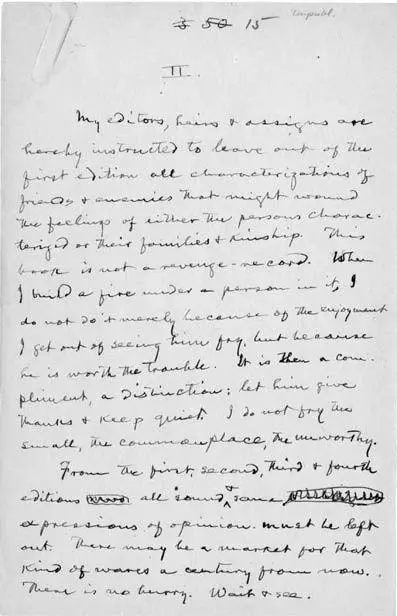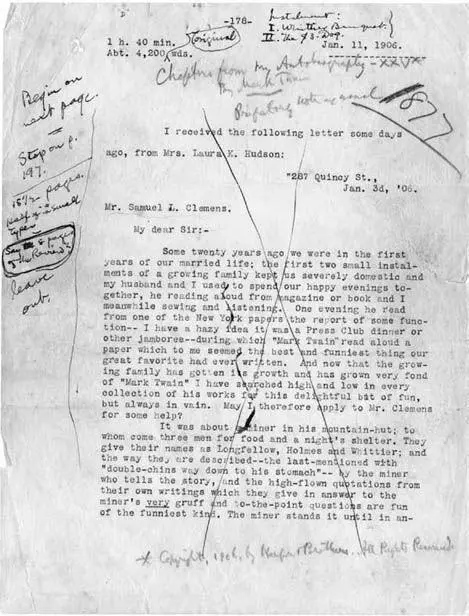Manuscript page 49, the second page of “As from the Grave,” first numbered 2 and later changed to 49. Clemens initially ended the preface at the bottom of this page, then canceled his signature and added two more sections.

FIGURE 11. Manuscript page 50, section II of “As from the Grave,” which Clemens first numbered 3 and later changed to 50.

FIGURE 12. Manuscript page 51, section III of “As from the Grave,” which Clemens first numbered 4 and later changed to 51.

FIGURE 13. Manuscript page 52, “Here begin the Florentine Dictations,” which Clemens first numbered 48 and later changed to 52 when he inserted the four-page “PREFACE. As from the Grave.”
We now understand why there are often two, three, or even four nearly identical typescripts for the January through August 1906 Autobiographical Dictations. The resolution of this first part of the textual mystery shows, among other things, that TS1 is the primary source for the text of those dictations, and that when parts of TS1 are lost, the missing text can be reliably restored from either TS2 or TS4, because they were created by copying TS 1 before the losses occurred. Our understanding of the typescripts also helps to explain the multiple inscriptions on so many of their pages: they are the traces left behind by the editors and typists who collaborated with Clemens in 1906–9, and by the editors who published parts of the autobiography after his death, from Paine to DeVoto. The four typescript pages reproduced in facsimile in figures 14–17 illustrate some of the many hands that had to be identified and, above all, distinguished from Clemens’s own hand.
The North American Review (August and September 1906)
To recapitulate: by 21 June Clemens had read through and corrected all of TS1 that Hobby had so far typed (over nine hundred pages, probably through the dictation for 20 June 1906).87 He had reviewed his earlier manuscripts and selected at least those he wanted to begin with (he would later select several more, inserting them in later dictations). And he had written the title page and the several prefaces to frame those early pieces and introduce the 1906 dictations. Hobby began to create TS2, and an unidentified typist started TS4, probably as soon as Hobby made the revised TS1 available.
With all that in train, Clemens left Dublin on 26 June to be away for a month, in Boston and New York City, occasionally visiting Henry Rogers at his home in Fairhaven, Massachusetts, and joining him on his yacht, the Kanawha. Following Rogers’s advice, he met several times with the Harper executives and lawyers in order to resolve their mutual disagreements about the recent republication of Mark Twain’s Library of Humor. While in New York he also met with S. S. McClure and left with him some pages from the dictations about Susy—probably those of 2–7 February. McClure wrote Clemens about them on 2 July:
This is not a business letter it is a love-letter. I read the wonderful chapters of your autobiography all are wonderful, but the chapters about the dear dear child are the finest I have ever read in literature
I wept & loved & suffered & enjoyed

FIGURE 14. The first page of the Autobiographical Dictation of 11 January 1906 (TS2, 178). Clemens wrote in ink at the top of the page and in the left margin, and crossed out the entire page. The “$3-Dog” (which he suggested as part “II” of a Review installment) is from AD, 3 Oct 1907. David Munro, a Review editor, wrote the title, the author’s name, and an instruction to include the “Prefatory note as usual.” “1877” is in an unidentified hand. The excerpt was published in December 1907 (NAR 25), typeset directly from this page.

FIGURE 15. The first page of the Autobiographical Dictation of 12 January 1906 (TS2, 199). Clemens noted in ink in the left margin: “None of this is printable while I am alive. It is too personal. . . . Leave it till I am dead, then print all of it some day. SLC.” In pencil in the right margin, he wrote, “USE ONLY THE DREAM.” Stenographer Josephine Hobby wrote “Auto.
1 comment